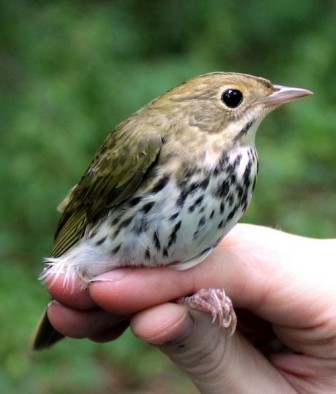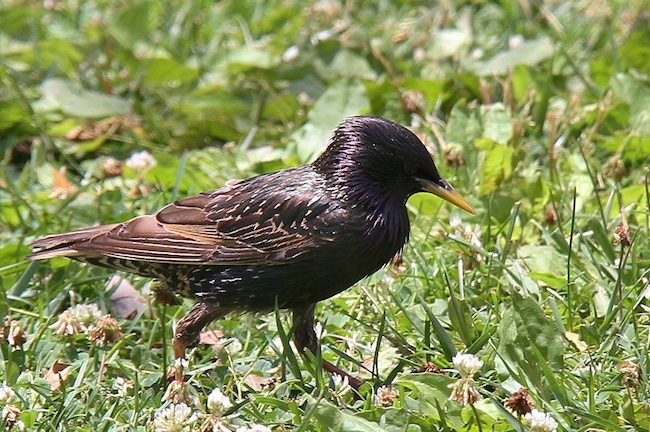By Colleen Otte

Ovenbirds were among the bird species studied. Image: Stephanie J. Beilke
When faced with assessing Great Lakes forest health, Wisconsin researchers figured this task is for the birds.
That’s not to say the status of forests isn’t worthy of consideration, of course. But birds reveal a great deal about the condition of a forest ecosystem, and form the basis of a new study “Sensitivity of breeding birds to the ‘human footprint’ in western Great Lakes forest landscapes.”
“Birds are great indicators of what’s happening in the forest,” said Nicholas Miller, one of the authors of the study recently published in the Ecological Society of America’s Ecosphere journal.
“We selected birds that respond in particular to the types of management that we’re seeing out there so that we would have a better understanding of what the resulting forest condition is,” said Miller, who is the science director for the Wisconsin chapter of the Nature Conservancy.
Forest birds are especially sensitive to the activities associated with humans, said Robert Howe, a University of Wisconsin—Green Bay professor of biology and environmental sciences. “They’re even better indicators than the animals in coastal wetlands where we developed the method in the first place.”
That’s why when a large tract of hardwood forest in northeastern Wisconsin was sold and parceled out to three separate owners, the Nature Conservancy asked Howe to form a research team to adapt his aquatic indicator method to see if birds could indicate the health of forests that are managed differently.
“He had applied it in Great Lakes wetlands before and this was a shot to apply it in a forested setting,” Miller said.
Northeastern Wisconsin’s Wild Rivers Legacy Forest is divvied up into three forms of management, Miller said. They include:
- State ownership that is managed for restoration.
- Working forest that supports jobs while protecting wildlife and the forest health.
- Land owned by timber companies and without wildlife protections.
Because protection of the forest varies at each owner’s discretion, researchers had the chance to evaluate which management method has the best conservation outcomes, Miller said.
This is where the birds chimed in. They provided a tool for assessing the health of the forests because their survival integrates complicated variables like climate, disturbance, habitat fragmentation and invasive species, Howe said.
Such variables form the human footprint. The study’s first objective was to model individual bird species’ responses to that footprint in Wisconsin and upper Michigan’s hardwood forests, said Erin Giese, the lead author of the study and a biodiversity research specialist at University of Wisconsin—Green Bay.
The second objective was to use these responses as indicators of forest health by plugging them into a computer model developed by Howe that relates the number of certain organisms to the health of an ecosystem.
That model, known as the Index of Ecological Condition, can be developed for any ecosystem type using different organisms, Giese said. In this case, the researchers incorporated newly-collected data detailing the presence and absence of birds in the forest to calculate forest health. The data was supplied by bird experts who recorded all birds they saw or heard from a stationary location for 10 minutes.
If a forest’s score is close to zero, it is a disturbed area–likely heavily managed or heavily degraded, Giese said. Numbers on the high end of the scale which ends at 10 indicate forests that are minimally degraded and near pristine.
An assemblage of certain birds generates one score, but a group of different birds nearby may score the forest very differently, Miller said. “The presence or absence of those birds is a function of forest condition, so you’re indirectly measuring forest condition.”

European Starling. Image: Scott A. Giese
For example, the European starling lowers a forest’s condition. The species is invasive and is commonly found within highly-fragmented forest landscapes, perhaps surrounded by agriculture or development, Giese said. But the presence of an interior forest species such as the ovenbird requiring high-quality habitat will score higher.
The researchers chose not to study the birds’ behavior like nesting habits, because it is incredibly time and resource intensive, Miller said. But birds sing their presence. By simply listening for their songs it’s possible to learn the condition of the forest.
“It’s really the combination of species at a site rather than the characteristics of any one species,” Miller said.
To build the Index of Ecological Condition the researchers used bird data collected in northern Wisconsin and parts of Michigan’s Upper Peninsula, Giese said. They then tested it in northeastern Wisconsin’s Wild Rivers Legacy Forest.
Preliminary results, which Miller said are not yet statistically significant but revealed a few trends, suggest both the state-owned lands and the timber company lands under easement and certification maintained their condition well.
Meanwhile, the timber company lands without restrictions have begun to degrade.
The research team plans to apply the model to more forested areas throughout Wisconsin, Michigan and northern Minnesota, Giese said. They are collaborating with various agencies willing to share their bird count data and they hope that the tool can be applied across all northwestern Great Lakes states.
“We’re focusing on that region because that’s where the forests are similar and the bird communities are similar,” she said.
The method can help measure the effectiveness of the Nature Conservancy’s conservation easements. These easements, which keep land open for recreation but ensure sustainable management, can protect more land than spending limited dollars to buy entire tracts to protect them.
“The preliminary results suggest that you can maintain conservation value of a forest and still maintain the use of that forest for people–for timber harvesting, for jobs, for paper, etc.–as long as it’s done in a sustainable way,” Miller said.
Thank you for the thought provoking article. I am curious if this might function on a small urban natural area. Could the Index of Ecological Condition accurately describe the condition of an area smaller than 40 acres?